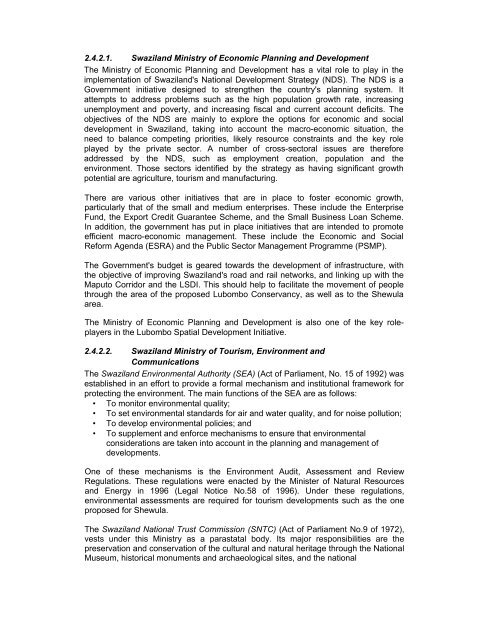Feasibility Study of Proposed Tourism Dev in Shewula, NE ...
Feasibility Study of Proposed Tourism Dev in Shewula, NE ...
Feasibility Study of Proposed Tourism Dev in Shewula, NE ...
Create successful ePaper yourself
Turn your PDF publications into a flip-book with our unique Google optimized e-Paper software.
2.4.2.1. Swaziland M<strong>in</strong>istry <strong>of</strong> Economic Plann<strong>in</strong>g and <strong>Dev</strong>elopment<br />
The M<strong>in</strong>istry <strong>of</strong> Economic Plann<strong>in</strong>g and <strong>Dev</strong>elopment has a vital role to play <strong>in</strong> the<br />
implementation <strong>of</strong> Swaziland's National <strong>Dev</strong>elopment Strategy (NDS). The NDS is a<br />
Government <strong>in</strong>itiative designed to strengthen the country's plann<strong>in</strong>g system. It<br />
attempts to address problems such as the high population growth rate, <strong>in</strong>creas<strong>in</strong>g<br />
unemployment and poverty, and <strong>in</strong>creas<strong>in</strong>g fiscal and current account deficits. The<br />
objectives <strong>of</strong> the NDS are ma<strong>in</strong>ly to explore the options for economic and social<br />
development <strong>in</strong> Swaziland, tak<strong>in</strong>g <strong>in</strong>to account the macro-economic situation, the<br />
need to balance compet<strong>in</strong>g priorities, likely resource constra<strong>in</strong>ts and the key role<br />
played by the private sector. A number <strong>of</strong> cross-sectoral issues are therefore<br />
addressed by the NDS, such as employment creation, population and the<br />
environment. Those sectors identified by the strategy as hav<strong>in</strong>g significant growth<br />
potential are agriculture, tourism and manufactur<strong>in</strong>g.<br />
There are various other <strong>in</strong>itiatives that are <strong>in</strong> place to foster economic growth,<br />
particularly that <strong>of</strong> the small and medium enterprises. These <strong>in</strong>clude the Enterprise<br />
Fund, the Export Credit Guarantee Scheme, and the Small Bus<strong>in</strong>ess Loan Scheme.<br />
In addition, the government has put <strong>in</strong> place <strong>in</strong>itiatives that are <strong>in</strong>tended to promote<br />
efficient macro-economic management. These <strong>in</strong>clude the Economic and Social<br />
Reform Agenda (ESRA) and the Public Sector Management Programme (PSMP).<br />
The Government's budget is geared towards the development <strong>of</strong> <strong>in</strong>frastructure, with<br />
the objective <strong>of</strong> improv<strong>in</strong>g Swaziland's road and rail networks, and l<strong>in</strong>k<strong>in</strong>g up with the<br />
Maputo Corridor and the LSDI. This should help to facilitate the movement <strong>of</strong> people<br />
through the area <strong>of</strong> the proposed Lubombo Conservancy, as well as to the <strong>Shewula</strong><br />
area.<br />
The M<strong>in</strong>istry <strong>of</strong> Economic Plann<strong>in</strong>g and <strong>Dev</strong>elopment is also one <strong>of</strong> the key roleplayers<br />
<strong>in</strong> the Lubombo Spatial <strong>Dev</strong>elopment Initiative.<br />
2.4.2.2. Swaziland M<strong>in</strong>istry <strong>of</strong> <strong>Tourism</strong>, Environment and<br />
Communications<br />
The Swaziland Environmental Authority (SEA) (Act <strong>of</strong> Parliament, No. 15 <strong>of</strong> 1992) was<br />
established <strong>in</strong> an effort to provide a formal mechanism and <strong>in</strong>stitutional framework for<br />
protect<strong>in</strong>g the environment. The ma<strong>in</strong> functions <strong>of</strong> the SEA are as follows:<br />
• To monitor environmental quality;<br />
• To set environmental standards for air and water quality, and for noise pollution;<br />
• To develop environmental policies; and<br />
• To supplement and enforce mechanisms to ensure that environmental<br />
considerations are taken <strong>in</strong>to account <strong>in</strong> the plann<strong>in</strong>g and management <strong>of</strong><br />
developments.<br />
One <strong>of</strong> these mechanisms is the Environment Audit, Assessment and Review<br />
Regulations. These regulations were enacted by the M<strong>in</strong>ister <strong>of</strong> Natural Resources<br />
and Energy <strong>in</strong> 1996 (Legal Notice No.58 <strong>of</strong> 1996). Under these regulations,<br />
environmental assessments are required for tourism developments such as the one<br />
proposed for <strong>Shewula</strong>.<br />
The Swaziland National Trust Commission (SNTC) (Act <strong>of</strong> Parliament No.9 <strong>of</strong> 1972),<br />
vests under this M<strong>in</strong>istry as a parastatal body. Its major responsibilities are the<br />
preservation and conservation <strong>of</strong> the cultural and natural heritage through the National<br />
Museum, historical monuments and archaeological sites, and the national












